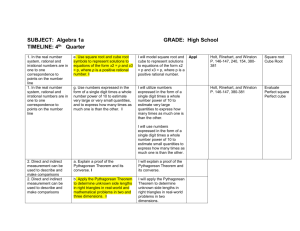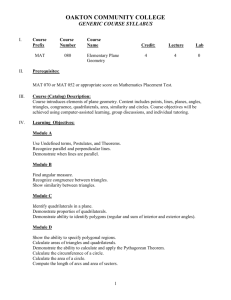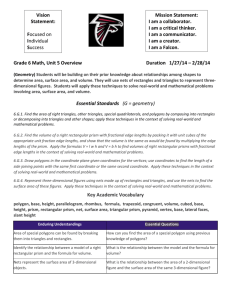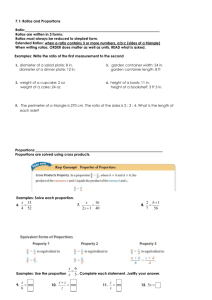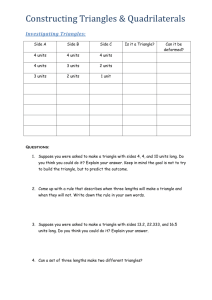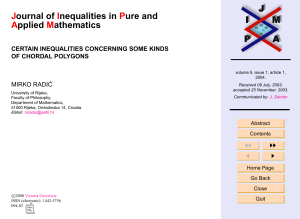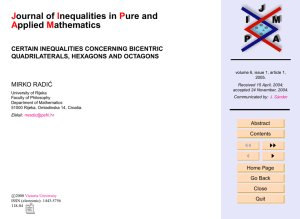Algebra 1a GRADE: High School TIMELINE: 3 rd Quarter
advertisement
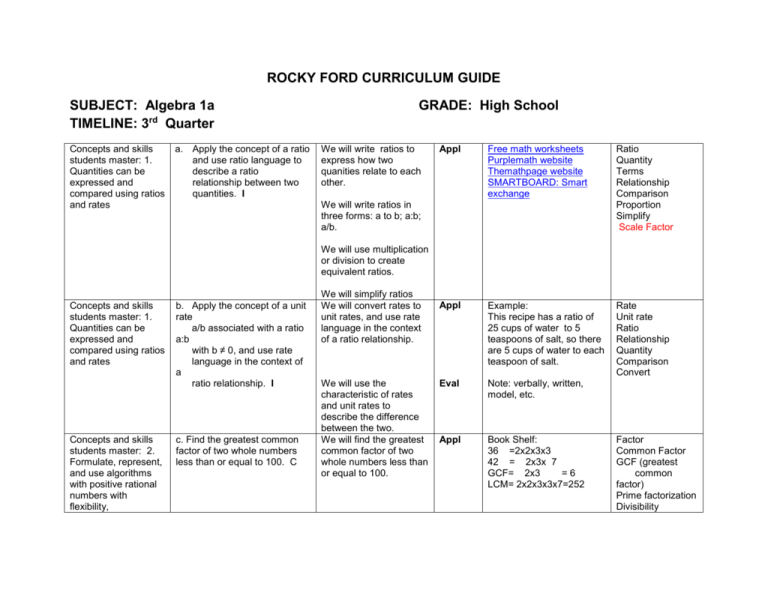
ROCKY FORD CURRICULUM GUIDE SUBJECT: Algebra 1a TIMELINE: 3rd Quarter Concepts and skills students master: 1. Quantities can be expressed and compared using ratios and rates a. Apply the concept of a ratio and use ratio language to describe a ratio relationship between two quantities. I GRADE: High School We will write ratios to express how two quanities relate to each other. Appl Free math worksheets Purplemath website Themathpage website SMARTBOARD: Smart exchange Ratio Quantity Terms Relationship Comparison Proportion Simplify Scale Factor Appl Example: This recipe has a ratio of 25 cups of water to 5 teaspoons of salt, so there are 5 cups of water to each teaspoon of salt. Rate Unit rate Ratio Relationship Quantity Comparison Convert Eval Note: verbally, written, model, etc. Appl Book Shelf: 36 =2x2x3x3 42 = 2x3x 7 GCF= 2x3 =6 LCM= 2x2x3x3x7=252 We will write ratios in three forms: a to b; a:b; a/b. We will use multiplication or division to create equivalent ratios. Concepts and skills students master: 1. Quantities can be expressed and compared using ratios and rates Concepts and skills students master: 2. Formulate, represent, and use algorithms with positive rational numbers with flexibility, b. Apply the concept of a unit rate a/b associated with a ratio a:b with b ≠ 0, and use rate language in the context of a ratio relationship. I c. Find the greatest common factor of two whole numbers less than or equal to 100. C We will simplify ratios We will convert rates to unit rates, and use rate language in the context of a ratio relationship. We will use the characteristic of rates and unit rates to describe the difference between the two. We will find the greatest common factor of two whole numbers less than or equal to 100. Factor Common Factor GCF (greatest common factor) Prime factorization Divisibility accuracy, and efficiency Concepts and skills students master: 2. Formulate, represent, and use algorithms with positive rational numbers with flexibility, accuracy, and efficiency Concepts and skills students master: 2. Formulate, represent, and use algorithms with positive rational numbers with flexibility, accuracy, and efficiency Concepts and skills students master: 2. Formulate, represent, and use algorithms with positive rational numbers with flexibility, accuracy, and efficiency Concepts and skills students master: 2. Variables are used to represent unknown quantities within equations and inequalities Concepts and skills students master: 2. Variables are used to d. Find the least common multiple of two whole numbers less than or equal to 12. C We will find the least common multiple of two whole numbers less than or equal to 12. Appl See above Common multiple LCM (least common multiple) Prime factorization e. Use the distributive property to express a sum of two whole numbers 1–100 with a common factor as a multiple of a sum of two whole numbers with no common factor. M We will factor the sum of two numbers. Appl Example: 4+8 = 4(1+2) Distribute Property Distributive Property GCF f. Interpret and model quotients of fractions through the creation of story contexts. C We will create a story problem which uses quotients of fractions 4+8 4(1) + 4(2) 4(1+2) Synth We will draw and describe (annotate) a model/diagram/picture that represents a story problem which uses quotients of fractions d. Solve real-world and We will solve real-world and mathematical problems by writing mathematical problems by and solving writing and solving equations of the form x + p = q and equations in algebraic form. px = q for cases in which p, q and x are all nonnegative rational numbers. I e. Write an inequality of the form x We will write an inequality > c or x < c to represent a constraint of the form x > c or x < c to or condition in a real-world or represent a constraint Quotient Dividend Divisor Reciprocal Multiplicative Inverse Model Diagram Annotate Appl Analysis Examples: Finding the cost of concrete for a tetherball court. Determining the amount of gas needed to drive to Disney World. Example; Xavier’s allowance is more than Cindy’s. Algebraic form Constraint represent unknown quantities within equations and inequalities Concepts and skills students master: 2. Variables are used to represent unknown quantities within equations and inequalities mathematical problem. I or condition in a real-world or mathematical problem. f. Show that inequalities of the form x > c or x < c have infinitely many solutions; represent solutions of such inequalities on number line diagrams. I We will show that inequalities of the form x > c or x < c have infinitely many Solutions by representing solutions of such inequalities on number line diagrams. Concepts and skills students master: 1. Objects in space and their parts and attributes can be measured and analyzed a. Develop and apply formulas and procedures for area of plane figures i. Find the area of right triangles, other triangles, special quadrilaterals, and polygons by composing into rectangles or decomposing into triangles and other shapes. I ii. Apply these techniques in the context of solving real-world and mathematical problems. I Analysis See above Infinite We will develop and apply formulas to find the area of triangles, quadrilaterals, and polygons. Analysis & Synt We will use the formulas we’ve developed and other problem solving strategies to find the area in real-world situations. Appl Find the area of right triangles, other triangles, special quadrilaterals, and polygons by composing into rectangles or decomposing into triangles and other shapes SMARTBOARD:Smart exchange Area Square units Plane figures Polygons Formulas Quadrilaterals Compose Decompose
